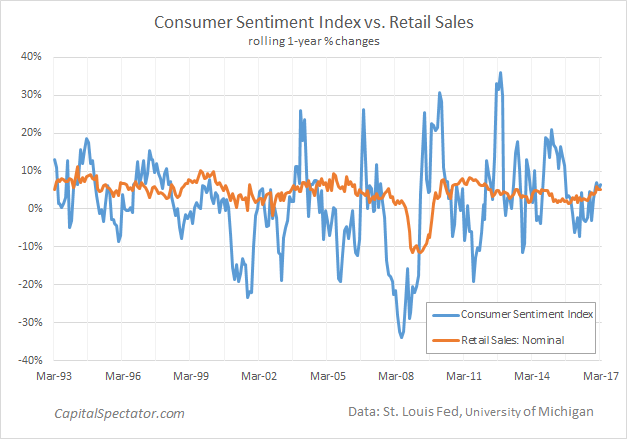Bitcoin price today: steady near $87k after soft US CPI data, set for weekly loss
Judging by media, blogosphere, and Wall Street reports in recent weeks, it’s tempting to assume that the so-called soft economic data – surveys of spending plans, expectations, etc. – have become disconnected from reality, defined by the hard data, such as payrolls, sales, and production.
Morgan Stanley, for example, recently advised that “there is a record gap between the strength of ‘hard’ and ‘soft’ US macro data.” But the devil’s in the details for quantifying this divide. In the case of Morgan Stanley’s provocative claim, the smoking gun is derived from the hard and soft components in the Bloomberg US Economic Surprise Index, which aggregates data from various sources.
But what’s true from a top-down perspective may not hold when crunching the numbers from the bottom up. Consider how US retail sales compare with the University of Michigan’s Consumer Sentiment Index, which jumped this month to a 17-year high. This buoyant mood implies that the economy (or at least retail spending) is on a tear. In fact, economists expect that the US economic growth will decelerate to a sluggish rate in next week’s first-quarter GDP report. Meantime, retail spending fell in February and March, posting the first back-to-back losses in more than a year. The gap between hard and soft data, in other words, seems to be wide and conspicuous.
Or is it? If we compare retail sales and the sentiment index through the same filter, the divergence fades quite a bit. Consider: retail spending touched a record high in January — $473.104 billion and the March update is only one-half of one-percent below that peak.
Misleading? Perhaps. Let’s dig deeper and strip out some of the short-term noise by comparing the consumer sentiment index and retail sales in rolling one-year percentage terms. By this definition, recent history doesn’t look all that unusual. Sentiment and spending have increased at similar rates for the past year: 6.5% and 5.2%, respectively.

To the extent that there’s anything unusual about the year-over-year changes these days, it’s the similarity. The two benchmarks of consumer behavior are usually far apart. In late-2012, for instance, the sentiment index surged more than 30% in year-over-year terms while retail spending was rising at just 4%-5%. By that standard, there’s no sign of divergence in recent history.
For a closer look, let’s zoom in on the past year, as shown in the next chart below. From this view, sentiment has only recently caught up with the firmer pace of retail spending. That doesn’t fit the narrative of late, which raises the question: Is the soft-data/hard-data meme fake news? Not entirely, but some folks have gone off the deep end by torturing the data and claiming that the divergence is off the scales.

To be fair, different data sets will yield different results when analyzed on a case-by-case basis. But the consumer sector is the biggest piece of the economy and so it’s reasonable to start here for deciding if expectations have become divorced from real-world events.
As per the analysis above via rolling one-year results, it’s not obvious that sentiment has run amuck relative to sales on Main Street. Why haven’t we heard this news shouted from rooftops and discussed endlessly by the usual suspects? Because it’s not all that compelling from a news perspective. And therein lies another dirty little secret regarding clear-eyed economic analysis and the media: reality isn’t always a compelling read.
